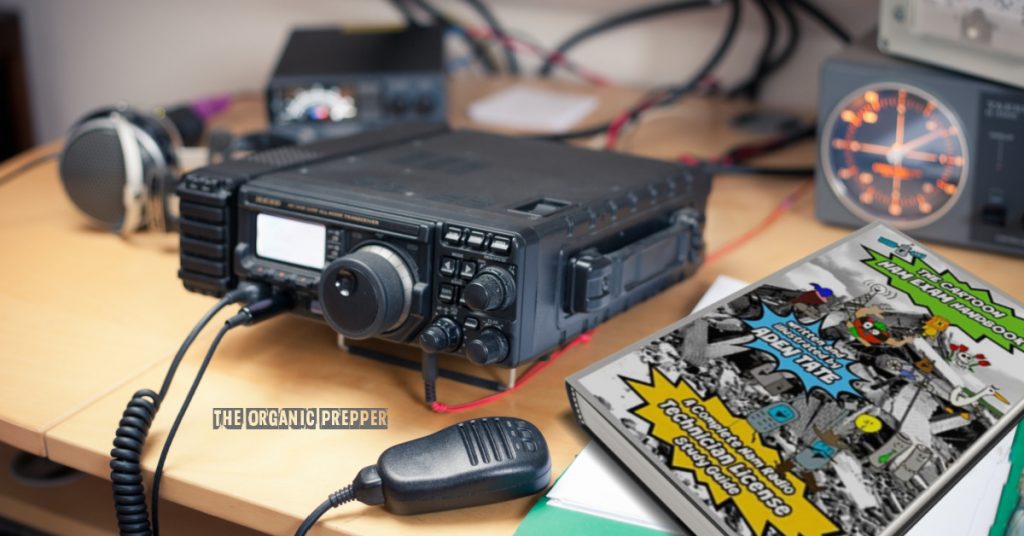by Amy Allen, The Organic Prepper:

I sat for my first ham radio license yesterday as of this writing. I passed with a score of 34/35. Although it’s a pass/fail thing, I’m happy to see that my efforts studying weren’t wasted. Soon I’ll be able to practice with my new to me Yaesu FT60R. I do have a Baofeng UV5R purchased a number of years ago, but the Yaesu is easier to program, and since I bought it from a local ham, it came with the local repeater frequencies pre-programmed.
TRUTH LIVES on at https://sgtreport.tv/
I did this because ham radio works in an emergency when the cell phone towers don’t. The Cajun Navy used ham to coordinate rescue activities post-Katrina. They’ve moved on to social media since then but can always fall back to ham if necessary. They’re credited with saving 10,000 lives post-Katrina. Bob Griswold used a ham radio to save a life during a bike race.The fact is that ham radio works where cell phones do not.

But I’m here to tell you: this isn’t the easiest skill to learn. Therefore, it seems better to me to learn it BEFORE I need it. Read on to learn about my journey, strategy, and the resources I used to get my Technician license.
How I decided to jump into ham radio
I’d been thinking about this for a while, mostly due to reading articles here on tOP and hanging out in the preppersphere. Our First World society relies heavily on technology. All it takes is a good hurricane, tornado, or attack on the local cell phone network to take that stuff out, leaving us without a reliable means to communicate. How do we contact our family? How do we gain the information we need in order to survive, not only immediately post-collapse but after death has cleared out the suckers?
(Other reasons to learn about ham can be found here.)
The first thing I needed was learning material.
Many people, including myself, can read a book, but I freelance in the publishing industry. I get paid to read until my eyes are falling out, so reading more isn’t my first choice when I log off for the day. There are a number of online platforms for studying ham radio, though, and I eventually settled on Ham Radio Prep.
The video format suits my learning style, they have many games, practice quizzes, and full practice exams, and the price was good. Buying the full package also includes a “Baofeng Basics” course, which I needed because the Baofeng user manual isn’t terribly user-friendly. I also acquired both of Aden’s manuals as study aids.
The first of Aden’s manuals provides an excellent overview of the various forms on radio, including ham, GMRS, FRS, and MURS. The language of physics is translated into a very readable form there, too. The exam book uses picture aids to help retain the information.
The Cartoon Ham Exam Handbook is now available in paperback on Amazon. Go here to find out how you can get a free gift for buying it this weekend!
There are over 400 questions in the pool that the test is drawn from randomly.
The more I studied, the better I felt.
However, I soon noticed that Ham Radio Prep was very much teaching to the test. All of the information is there, but their method helps memorize the answers more than learning the information. That’s a bit sloppy IMO. I’d rather understand how to do stuff.
A bit more research led me to https://hamexam.org/. This site is free to use and offers flashcards, more in-depth and difficult practice exams, and the question pool for perusal. They also have phonetic alphabet flash cards! If you create an account, you’ll have access to statistics that are broken down by lesson. (Ham Radio Prep does this, also.)
Lastly, I downloaded the American Radio Club practice exam app from the App Store. So, I had three sources for practice exams. My study strategy was simple: I went through all of the lessons on Ham Radio Prep, then started taking practice exams. Whichever section I flunked out the worst on, I went back to that lesson and reviewed the material, then took another full practice exam. I went on in this vein for perhaps two weeks, 30 minutes or so every evening, until I was scoring well enough on the practice exams to feel ready for the real one. This translates into an average score of 85% on my practice exams. 74% is a passing grade, and the exams are multiple-choice. At that point, I had to find an exam.
(Getting involved in ham radio is a great way to learn how to starve the beast. You can learn more tips on how to do that by reading our free QUICKSTART Guide on the subject here.)
Here’s where the real fun started!
There are two basic options for taking a ham exam: in-person and online. Since I don’t drive, online sounded pretty good, so I started looking around for one. I used the ARRL site, and, yes, got my FRN# and CORES registration squared away.
It turns out there are a number of viable options for an online exam, and since the closest in-person exam I could find was 150 miles away, I dug a bit more into their requirements. Let me summarize, and if you don’t believe me, check out these proctors. Click on any of their websites to learn their procedures. It’s instructive, to say the least. That is how I found HamExam, in fact. A lovely representative sample of online exam requirements is here.
Read More @ TheOrganicPrepper.ca



